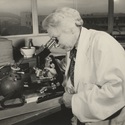Gold is the stuff of dreams and legends. Empires have been toppled for it, pirates have plundered it and misers have hoarded it. But what does gold mean for science, and does it have a purpose beyond bling and sporting medals?
Element facts
Gold is a chemical element – a substance that contains only one type of atom. Its official chemical symbol is Au, and its atomic number is 79, which means that a gold molecule has 79 protons in its nucleus. Gold is the most malleable of all metals – 1 gram of gold can be hammered into a 1 square metre sheet of gold foil. For reference, a stick of gum weighs about 1 gram. Imagine stretching even the chewiest piece of gum into 1 square metre!
Gold is a noble metal along with silver, platinum, palladium and a few others. The noble metals resist oxidation and corrosion in humid air, which is why they are often used in coinage and jewellery. The noble metals are all found close to one another in the periodic table of elements.
Gold’s cosmic origins (and those closer to home)
Scientists are not certain about the origin of the Earth’s gold deposits. They think that gold dust is produced when neutron stars collide, but ideas differ about why we find it in Earth’s crust and mantle. Scientists believe that gold dust was present when the Solar System was formed. However, the Earth was a molten liquid when it formed, so heavy elements like gold likely sank into the core. One idea is that the gold present in Earth’s crust and mantle came from meteors nearly 4 billion years ago when billions of tonnes of space rocks landed on Earth. A second hypothesis has recently come to light. It suggests that tectonic plate movements allowed metal-rich fluids to come through very deep cracks and form gold deposits near the Earth’s surface.
Gold is found in many forms. Hot fluid can pick up gold as it flows through fractures in the Earth, leaving very tiny particles embedded in quartz veins. Examples of this are found on the Coromandel Peninsula. Gold and silver-bearing rock has to be crushed and chemically treated to get the precious element. Alluvial gold – like that found in Otago and the West Coast – has been eroded from the rocks and can be found as small flakes or larger nuggets in river gravel.
The most ancient of known elements
Gold is the only truly yellow metal found on Earth, and it can be found in its pure elemental form. Gold is thought to be the first recorded metal worked by humans. Evidence shows an association between humans and gold dating back to 40,000 BC.
We tend to measure and weigh gold with fairly old methods too. Gold is measured with a carat (ct) rating – the purest form of elemental gold is 24-ct. Alloys of gold include 18-ct (18 parts gold and 6 parts other metals), 12-ct (12 parts gold and 12 parts other metals) and so on. The word ‘carat’ comes from the word ‘carob’ – the seed that was used to balance the scales in ancient Asian markets. Gold is still traded in troy ounces – a unit that dates back to the Middle Ages. The troy ounce (31.10 g) is heavier than a standard ounce (28.35 g).
The chemical symbol for gold is Au – from ‘aurum’, the Latin word for gold. The word aurum is derived from an even earlier word that means ‘glow’.
Modern applications
Gold doesn’t corrode, it’s an excellent conductor of electricity and its malleability means it is easy to work with. A small quantity of gold is found in almost every electronic device from cell phones to GPS units to computers. Its use in electronic circuitry is cost-effective due to its reliability. Corrosion or tarnish can interrupt electrical currents – that’s not something we want to happen to microprocessors and memory chips!
Related content
Gold has many uses in technology. Read how Massey University scientists worked to extract gold nanoparticles from plants.
Useful links
ScienceDaily reports on the origin of gold, one of the most intriguing mysteries for humankind since ancient times.
Geology.com explains the many uses of gold.
The 2020 Olympic medals are made from metals extracted from consumer electronics.





